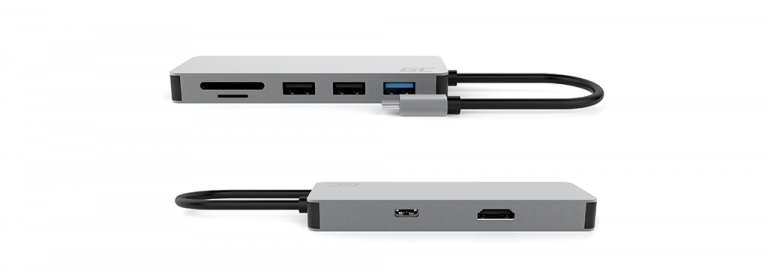The progressive miniaturization of our mobile devices is a trend we are already used to. It’s smaller, faster and lighter media, 4K resolution even in smartphones and, of course, flat like a notebook for plastics, which are the heroes of today’s entry.
Aesthetics versus usability
If you have a new MacBook or one of the new Ultrabook models, you’re sure to have a problem with the title – very few ports. Some MacBooks, for example, have only 1 or 2 USB-C ports, depending on the version, and one of them is also a power port. So while we’re charging, we can stay without any USB-C port on the whole laptop! This trend is already visible in virtually all notebook manufacturers. Excellent examples are the Dell XPS 15, Microsoft Surface Pro and MacBook models from 2016.
In the era of extremely fast wireless connectivity, we’re actually doing better without cables. Wireless mice, game controllers… we don’t even need an HDMI port to transmit video to most TVs. Sounds perfect, right? Unfortunately, almost everyone who owns one of the newer MacBooks has no hesitation in saying it’s far from perfect. Let me explain why.

First of all, you just have to buy all that wireless equipment. Don’t even try to tell me that you have all these wireless devices, because I won’t believe it anyway. The very fact that they are more expensive than those with a cable is already quite a problem, and there is a limited choice of products.

Here’s a sample scenario: we have our favorite wired gaming mouse that we can’t part with, we need to use our old printer or other office equipment, and in general we would like to connect via HDMI to a larger monitor and charge the lapel at the same time. No chance. Of course, if we aren’t particularly attached to our older equipment, you can replace it all, spend a lot of money and be happy that we are finally fully wireless and compatible, but is that for sure?
Not exactly. We are left with the question of a whole lot of devices, which we simply cannot use. Simple devices like portable drives and flash drives suddenly turn out to be beyond our reach. They have to be wired up and done. I think you can let go of all the other specialist devices like graphics tablets and microphones. They all wait time out until we get more ports.

The end of the tiresome – USB-C Green Cell adapter arrives
All the above analysis comes down, of course, to a simple solution to the problem, which is the Green Cell Hub USB-C docking station. This small box is the cure for all the above problems. We attach the adapter to the laptop and our capabilities expand immediately, we replace one port with 7. What exactly do we get?
3x USB-A – the most obvious victims of miniaturization, we get 2 USB ports in version 2.0 and one 3.0
1x HDMI – allows for image transmission in 4K in 30Hz and in Full HD in 60Hz
1x SD card slot
1x micro SD card slot
1x USB-C input – this is very important, connecting the Green Cell docking station does not mean that the remaining free port in your laptop has to be used for charging. The Hub has a USB-C input port that supports fast charging with Power Delivery technology, used by MacBooks among others. Maximum power is up to 87W.

Not only for laptops!
In addition to working with laptops, the Hub also supports the smartphone desktop function. How does it actually work? It’s easy, you connect the docking station to the USB-C port on your smartphone, and connect the hub to your TV or monitor via HDMI cable. We still have to connect the keyboard, mouse and voila! We can use the phone like a fully-fledged computer. Of course this option is only available for smartphones that have a desktop mode. This is a standard feature in the latest Huawei and Samsung smartphones. Green Cell Hub can be used interchangeably with Samsung Dex.
Author: Krzysztof Wołongiewicz
Related posts
Most viewed entries
- Electricity in a camper van on holiday – a conundrum easily solve
- Off-grid installation on a plot. Is it worth it?
- Charging your electric car at home without a wallbox
- Inverter – what it is and what it is used for
- Zero VAT on energy storage in the UK possible soon
- Greece sets aside €200 million for photovoltaic subsidies!

